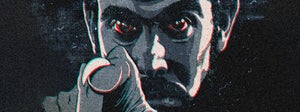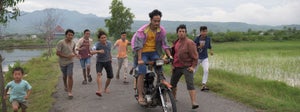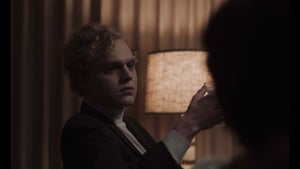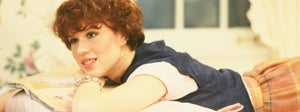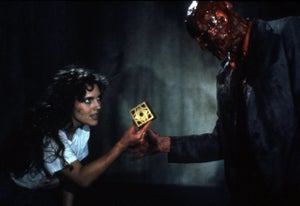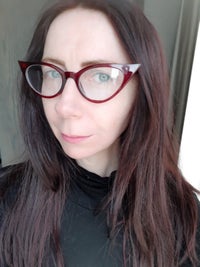
Horror loves fashion, and fashion loves horror. From the ghoulish fashion photographer of Vogue stalwart Guy Bourdin to the Trussardi fashion parade Dario Argento directed in the mid-80s (complete with a model being dragged off the catwalk in a body bag), horror and high fashion in particular have long been perverse bedfellows. Fashion brings an added spectacle to horror’s focus on transgressive (usually female) bodies, our focus on clothing often making us acutely aware of the flesh that lies hidden underneath. And, as demonstrated in a small but impressive subgenre of sorts, the fashion world has proven to be a rich source of inspiration for filmmakers who have chosen to set their dark tales against a backdrop of the industry.
While not horror movies per se, Swedish filmmaker Arne Mattson's duo The Lady in Black (1958) and The Mannequin in Red (1958) are early examples of movies that delighted in setting their respective murder mysteries in the fashion industry, featuring a steady stream of beautiful women under threat as they go about their professional duties as models, designers or sales girls. These films are surely one of the many significant precursors to the Italian giallo films where fashion references are abundant in many of the movie titles alone, such as A Black Veil for Lisa (Massimo Dallamano, 1968), Death Walks on High Heels (Luciano Ercoli, 1971), A White Dress for Marialé (Romano Scavolini, 1972), and Fashion Crimes (Bruno Gaburro, 1989).
Fashion accessories often play a key part in many giallo mysteries, including in Sergio Martino's The Case of the Scorpion's Tail (1971) and Torso (1973), as well as Argento's Four Flies on Grey Velvet (1971) and Sergio Pastore’s Seven Shawls of Yellow Silk (1972). Argento’s passion for fashion would recur across his filmography, even bringing iconic Italian fashion designer Giorgio Armani on board the costuming department of his 1985 film Phenomena.
But of course, when it comes to Italy at least, it’s hard to go past Mario Bava as the grandaddy of the fashion-centred horror movie. Hatchet for a Honeymoon (1970) is set in the world of bridal wear fashion design, and his love of costume as a source of vivid spectacle peaked perhaps nowhere more brazenly than in Edwige Fenech’s unforgettable sequins-and-gold-lamé dress striptease dance at the start of Five Dolls for an August Moon (1970).
https://www.youtube.com/watch?v=WCb-GiEj5xw
But it was of course one of the first gialli ever made - his 1964 film Blood and Black Lace - where Italian horror would find itself forever connected to the fashion world. Set in Rome at a Haute Couture design house, a series of murders plagues its employees - particularly an unfortunate stream of young, beautiful models who Bava clearly delighted in placing at the centre of a series of gory horror vignettes, renowned as the film’s primary drawcard. Establishing a trend that many Italian filmmakers would turn to across the golden years of the giallo, the fashion world would reappear as a central setting in movies ranging from Andrea Bianchi’s Strip Nude for Your Killer (1975) to The Red Queen Kills Seven Times (Emilio Miraglia, 1972) and beyond.
Fashion world set horror movies are of course not just an Italian affair, with Irvin Kershner's stylish supernatural classic Eyes of Laura Mars (1978) including fashion photography by the iconic Helmut Newton in its story of a psychic fashion photography played by Faye Dunaway who has visions of a series of brutal serial killings. Additionally, haunted garments have almost become a sub-subgenre of sorts, stemming back to Michael Powell and Emeric Pressburger's dark romantic fantasy The Red Shoes (1948) where a young ballerina falls under the spell of seemingly sentient ballet slippers. Tobe Hooper would more directly tackle the idea of haunted clothing in his 1990 TV movie I’m Dangerous Tonight starring Twin Peaks’s Mädchen Amick, the cursed dress motif also lying at the heart of Peter Strickland’s astonishing 2018 horror-comedy, In Fabric.
https://www.youtube.com/watch?v=biHUTtV4K40
Like In Fabric, Elza Kephart's Slaxx (2020) about a pair of killer jeans running rampant in a fashion boutique contains at its heart a fairly undisguised critique of fast fashion. But not all contemporary fashion-centric horror films have such industry-specific reflections on their mind. Edgar Wright's Last Night in Soho (2020) excels when it focuses on Thomasin McKenzie's protagonist's experience of moves from her country to the London of the swinging sixties to pursue her passion for fashion design at the London College of Fashion.
But contemporary horror’s fascination with fashion surely peaked nowhere more vividly than in Nicolas Refn Windig’s divisive 2016 film, The Neon Demon. A dizzying, glossy supernatural tale of a young model’s ascent to the top, Natasha Braier's lush cinematography and wild clothing including that designed by Austrian fashion designer Marina Hoermanseder combined with the real-life nightmare experiences brought to the project by model-turned-actress Abbey Lee, all creating Windig’s delirious portrait of the fashion world’s dark heart. As critical of the fashion industry as much as it delights in the rich, gendered spectacles it affords, horror filmmakers have long looked to the catwalk for inspiration - a fascination that shows no sign of slowing down.

Related Articles



